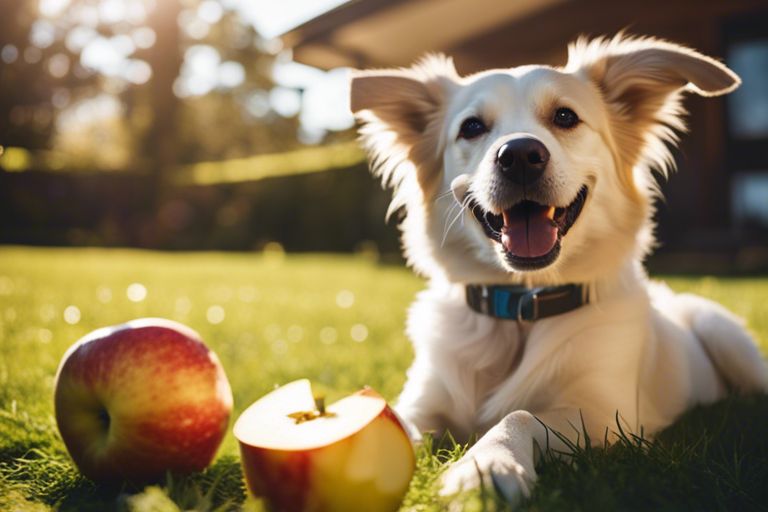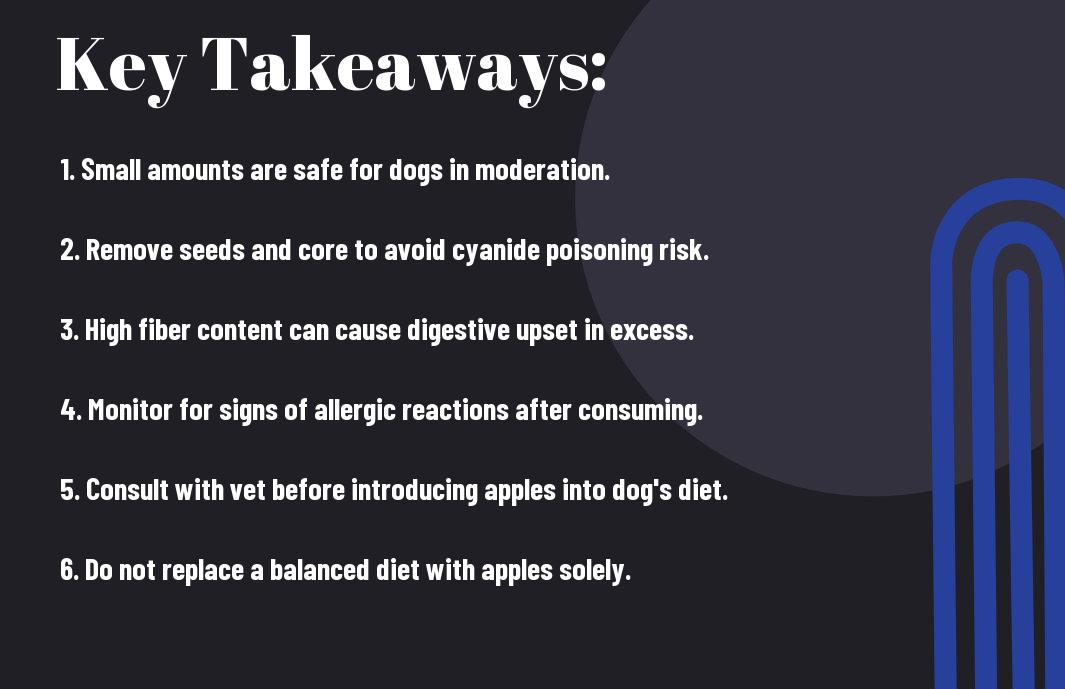Dog, oh dog, have you ever wondered how much apple you can safely eat? Apples can be a tasty treat for you, but too much can lead to a tummy ache, it’s true! Be mindful of, just a few slices a day, keeping the doctor away, they say. Core and seeds must be out of sight, to keep you healthy and feeling just right. So, grab a slice, don’t think twice, and enjoy a snack that’s oh so nice!
Key Takeaways:
- Apples in moderation: Dogs can enjoy apples as a tasty treat, but it’s important to feed them in moderation to prevent any digestive issues.
- Avoid the seeds: The core and seeds of apples should be avoided as they contain cyanide, which can be harmful to dogs if consumed in large quantities.
- Slice and serve: Before feeding apples to your furry friend, make sure to remove the core, seeds, and cut the apple into bite-sized pieces to prevent any choking hazards.
The Benefits of Apples for Dogs
While you may think of apples as a delicious snack for yourself, they can also provide numerous benefits for your furry friend. Apples are a great source of vitamins, minerals, and antioxidants that can help support your dog’s overall health and well-being.
Rich in Fiber
To start with, apples are rich in fiber, which can be beneficial for your dog’s digestive system. Fiber helps promote healthy digestion and can prevent issues like constipation. By including apples in your dog’s diet, you can help keep their digestive system running smoothly.
Antioxidant Properties
With apples containing antioxidant properties, they can play a role in reducing oxidative stress and inflammation in your dog’s body. Antioxidants help protect cells from damage and support overall immune function. By incorporating apples into your dog’s diet, you can help boost their antioxidant intake and promote better health.
With that said, it’s important to keep in mind that you should always remove the seeds and core of the apple before feeding it to your dog. The seeds contain cyanide, which can be harmful to your furry companion if ingested in large quantities. Stick to offering your pup sliced apple pieces without the seeds to ensure their safety.
Properties
Apples also contain phytonutrients that have been linked to reducing the risk of chronic diseases in dogs. These compounds can help support your dog’s overall health and may even play a role in preventing certain conditions. By adding apples to your dog’s diet in moderation, you can provide them with an extra boost of nutrition.
Supports Healthy Digestion
Supports With their high fiber content, apples can aid in promoting healthy digestion for your dog. Fiber acts as a natural prebiotic, feeding the beneficial bacteria in your dog’s gut and supporting a balanced microbiome. This can help improve your dog’s digestion, nutrient absorption, and overall gut health.
Understanding that apples should only be given to your dog in moderation is crucial. While they offer fantastic health benefits, too much of a good thing can lead to an upset stomach or weight gain. As a responsible pet owner, remember that apples should be incorporated into your dog’s diet as a treat or supplement, rather than a primary food source.
The Risks of Feeding Apples to Dogs
Choking Hazards
Some dogs may not chew their food thoroughly before swallowing, leading to a potential choking hazard when eating apples. With their round shape and firm texture, apple slices can pose a risk, especially for smaller breeds or dogs that are prone to gulping their food.
Allergic Reactions
Choking on a piece of apple can be a scary situation for your furry friend. It’s crucial to supervise your dog while they enjoy this treat and cut the apples into bite-sized pieces to reduce the risk of choking.
Allergic reactions to apples in dogs are rare but can occur. If you notice any signs of hives, itching, swelling, or difficulty breathing after feeding your dog apples, stop the consumption immediately and consult your veterinarian.
Overconsumption of Sugar
To avoid any potential issues, it’s best to feed apples to your dog in moderation. Too much sugar from apples can lead to digestive upset, including diarrhea and stomach discomfort.
Dogs metabolize sugars differently from humans, and consuming large amounts of sugary fruits like apples can result in unwanted symptoms. Note, moderation is key when sharing this fruit with your canine companion.
How Much Apple is Safe for Dogs?
Keep in mind that while apples can be a healthy treat for your furry friend, it’s crucial to offer them in moderation. Too much of a good thing, even apples, can lead to an upset stomach or other issues for your dog.
Size Matters: Apple Slices vs. Whole Apples
On the size front, consider giving your dog apple slices rather than a whole apple. The slices are easier for your dog to eat and digest compared to a whole apple, reducing the risk of choking or stomach discomfort.
Breed and Age Considerations
The breed and age of your dog can also play a role in how much apple is safe for them to consume. The size of the dog and any preexisting health conditions should be taken into account when determining the appropriate portion size.
The size of the apple slices can also be adjusted based on the size of your dog. Smaller dogs may benefit from smaller, bite-sized pieces to avoid any potential choking hazards.
Monitoring Your Dog’s Reaction
Apple can be a new addition to your dog’s diet, so it’s important to monitor how your dog reacts after eating it. Look out for any signs of digestive upset, such as vomiting or diarrhea, which could indicate that apples may not agree with your dog’s stomach.
Monitoring your dog’s reaction to apples can help you determine the right amount to incorporate into their diet. If your dog shows any unusual symptoms after consuming apples, it may be best to avoid feeding them this fruit in the future.
Preparing Apples for Your Dog
Washing and Drying
Drying your apple slices thoroughly after washing is crucial to ensure your dog’s safety. Any residual water left on the apple slices can result in a mushy texture and may lead to quick spoilage. A good tip is to use a clean kitchen towel to gently pat the apple slices dry before serving them to your furry friend.
Removing Seeds and Cores
Cores should always be removed before serving apples to your dog since they contain cyanide-releasing compounds that can be harmful. Simply using a knife to cut around the core and slice the apple into pieces will make it safe for your dog to enjoy.
The seeds should also be removed as they contain cyanogenic glycosides, which can be toxic to dogs if ingested in large amounts. Although a few seeds are unlikely to cause harm, it’s best to remove them completely to be on the safe side.
Cooking or Raw: Which is Best?
Drying apple slices in a food dehydrator is a great way to make tasty apple chips for your dog. By removing the moisture content, you can create a crunchy treat that your dog will love. Alternatively, serving fresh apple slices can provide a satisfying crunch and a burst of natural sweetness that many dogs enjoy.
For instance, cooking apples can make them more palatable for some dogs. Baking or steaming apple slices can soften them, making them easier for older dogs or those with dental issues to eat. However, feeding raw apples can retain more nutrients and offer a refreshing treat, especially during hot summer days.
Common Apple-Related Health Issues in Dogs
Gastrointestinal Upset
Once again, common apple-related health issues in dogs include gastrointestinal upset. Eating too much apple at once can lead to stomach discomfort, gas, diarrhea, or even vomiting in your furry friend. It’s imperative to introduce apples gradually into your dog’s diet to monitor their tolerance and prevent these digestive issues.
Allergic Reactions
AppleRelated allergic reactions may occur in some dogs, although this is less common. For instance, some dogs may be allergic to certain proteins in apples, leading to symptoms such as itchiness, rashes, or even swelling. If you notice any unusual reactions after feeding your dog apples, consult your veterinarian immediately to determine the cause and appropriate course of action.
Obesity and Weight Management
Gastrointestinal issues can arise in dogs that consume excessive amounts of apples, contributing to obesity and weight management concerns. While apples are a healthy treat, they should be given in moderation to prevent an imbalance in your dog’s diet. It’s important to consider your dog’s overall caloric intake and daily exercise routine when incorporating apples into their meals.
Alternatives to Apples for Dogs
Other Fresh Fruits
To give your furry friend a variety of flavors and nutrients, you can offer them other fresh fruits as a healthy snack. Fruits like bananas, blueberries, and strawberries are safe for dogs to eat in moderation. These fruits provide vitamins, minerals, and antioxidants that can benefit your dog’s overall health and well-being.
Vegetables and Snacks
Dogs can also enjoy a range of vegetables and snacks as a tasty treat. Carrots, green beans, and sweet potatoes are great options that can be served raw or cooked. These veggies are packed with fiber and imperative nutrients that can support your dog’s digestion and immune system.
Remember to always cut fruits and vegetables into bite-sized pieces to prevent choking hazards and remove any seeds or pits that could be harmful to your pup.
Commercial Dog Treats
The market is filled with a variety of commercial dog treats that come in different flavors, sizes, and textures. When identifying dog treats, opt for those made with natural ingredients and free from artificial flavors or preservatives. Look for treats that are specifically designed for dogs and approved by veterinary associations to ensure they are safe and nutritious for your furry companion.
This way, you can spoil your pup with delicious treats while providing them with imperative nutrients to support their health and happiness.
To wrap up
Drawing together, it’s important to remember that while apples can be a healthy and tasty treat for your dog, moderation is key. Too much apple can upset your dog’s stomach or lead to other issues, so it’s best to limit their intake and always remove the seeds and core. Remember to consult with your veterinarian if you have any concerns about introducing new foods to your furry friend’s diet. With a balanced and varied diet, your dog will be happy, healthy, and ready for all the adventures that come their way!
FAQ
Q: Can dogs eat apples?
A: Yes, dogs can eat apples! They are a healthy and tasty treat for your furry friend.
Q: How much apple is safe for dogs to eat?
A: It is safe for dogs to eat apples in moderation. A few small slices or cubes as an occasional treat is a good amount for most dogs.
Q: Are there any parts of the apple that are harmful to dogs?
A: Yes, it’s important to remove the apple seeds and core before giving it to your dog. These parts contain cyanide, which can be toxic to dogs if consumed in large amounts.
The Top Dog Breeds Recognized by the American Kennel Club
Dog Training 101: Train Your Pup




